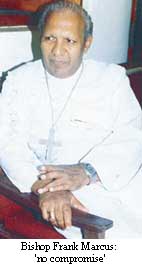

![]()
The Catholic Church is on collision course with the CEB as fears are expressed over the effects of the coal power plant on the Talawila shrine. Tharuka Dissanaike reports: - The Bishop of Chilaw was adamant. There could be no compromise. The Coal Power plant must not go ahead.
 "There
is definite scientific evidence that if this project goes ahead the Talawila
church will be adversely affected. The Catholic church is united on this-the
shrine must be preserved and therefore the coal power plant cannot go ahead
at this location," Rt. Rev. Frank Marcus Fernando, Bishop of Chilaw
said.
"There
is definite scientific evidence that if this project goes ahead the Talawila
church will be adversely affected. The Catholic church is united on this-the
shrine must be preserved and therefore the coal power plant cannot go ahead
at this location," Rt. Rev. Frank Marcus Fernando, Bishop of Chilaw
said.
In a recent letter to the President, the Bishop urges the government to abandon its plans for the power plant since they fear sea erosion which would result after the development of jetties on the coast would damage the shrine at Talawila. "If the proposed plant comes up at Nurachcholai, the shrine can altogether disappear," the letter states.
This had been the latest in a series of protest letters signed by Bishop Fernando that went out to the government. But there has been no official response according to the Bishop. "I have had discussions with officers from the CEB and their consultants, Electrowatt here at Chilaw. But these were informal meetings."
The coal power plant, planned to be built in Nurachcholai, six miles from the famous Talawila shrine was embroiled in controversy ever since the ground work on the site began. The villagers a mixed ethnic group of Sinhalese, Muslims and Tamils, a majority of whom are Catholics, staged a volatile demonstration in April which ended in the death of one person. At that stage the protests were mostly on the environmental impacts and the social problems the villagers face with the coming of a large power plant to a thriving little farming and fishing village on the arm of the Kalpitiya peninsula.
Suddenly, the issue is thrown into a wider perspective. The protest is brought closer home to many thousands of Catholics by the very fact that the Talawila shrine is in danger.
"For Catholics, there are two main shrines in this country. One is Madhu, which for practical purposes is non-commissioned. The other is Talawila," said Bishop Fernando.
The Talawila shrine apparently dates back to the Dutch persecution of Catholics in the early 18th century, when a group of European merchants were shipwrecked off its coast. With them they had a statue of St. Anne, which they hid in a tree when they safely reached the shore. The statue was later rediscovered and worshipped. Much later in the early 19th century a church was built at this very location dedicated to St. Anne.
The feast of St. Anne at this church is celebrated in August every year and draws huge crowds most whom come and camp for many days in the beach areas around the church.
 "Any
threat to the church would touch a raw nerve in the people," Bishop
Fernando said. Even non-Catholics in the area gain much during the time
of the feast," he said.
"Any
threat to the church would touch a raw nerve in the people," Bishop
Fernando said. Even non-Catholics in the area gain much during the time
of the feast," he said.
The church, Bishop Fernando said, has based its protests on documents released by the CEB ( Ceylon Electricity Board ) at a seminar at the BMICH in September. The church had solicited independent research on the power plant's presence in Kalpitiya.
"The effect of erosion is quite clear. Already this beach is eroding. The sacred well which supplied clean water to pilgrims, was located in the church garden. But now it is on the shore, filled with sand and eroded. This type of erosion will be accelerated by the building of jetties," the Bishop said.
There is good evidence of this on the coast of Wellamankare in Nainamadama where the sea had gobbled up vast areas of land when embankments were placed south of it.
The church's protests are not based on the shrine alone. It is also fighting against the pollution and social issues that would certainly crop up due to the power plant. The large population of fishermen would probably face a storm when security concerns would restrict fishing off the coast. Cultivation would suffer due to the pollution. And health problems would arise.
Security is also a concern. But what of the sophisticated pollution control technology that the CEB has promised to introduce to this plant?
"Our stock answer to this question is that our people are not known for maintenance and repair, especially in the state sector. Many hospitals have sophisticated machinery worth millions which just don't function when patients need them. This could almost be called our national weakness. We take as example the Cement Factory at Puttlam. The pollution caused by its dust has forced some villagers to evacuate," Bishop Fernando said
Is the church offering alternatives? "Oh no," the Bishop said. "We are only telling the government our problems. It is upto the State to find an alternative."
The church also protested vehemently against the Iranawila VOA project, which in the end went ahead. "I am notorious for fighting out these issues. Many people refer to the Iranawila experience. That too was in my diocese.
Well the project did go ahead. But many things we said about Iranawila are now coming to pass."
Is the church concerned that these protests might make them look rather anti-development?
"We are not anti- development. Whatever we do, it is after much deliberation, discussion and reflection."
Bishop Fernando said that in these areas he, as the Bishop was looked upto for guidance in people's problems. More importantly, the responsibility to protect the shrine at Talawila.
The church has prepared a booklet on the Talawila shrine and the dangers. It was planned to be distributed to a large gathering of people at the Talawila shrine last Friday. The peaceful protest was organised by the Bishop and many scientists too were scheduled to speak to a gathering expected to be 10,000.
"We will ask the people to lodge their complaints with the government to stop this coal power plant. When protest letters by their thousands roll in, they will open their eyes to the fact that this is not a potty little corner with a few men shouting. It is a much larger issue," the Bishop concluded.
Continue to Plus page 2 * CEB officials see no wrong
![]()
| HOME PAGE | FRONT PAGE | EDITORIAL/OPINION | NEWS / COMMENT | BUSINESS
Please send your comments and suggestions on this web site to
info@suntimes.is.lk or to
webmaster@infolabs.is.lk